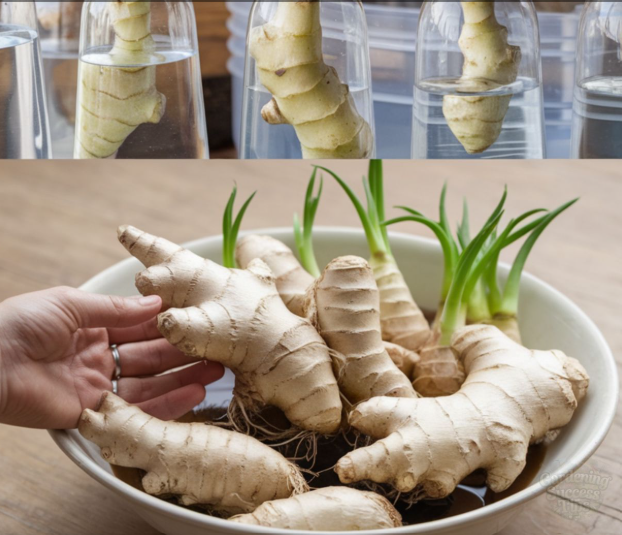Optional Step: Transplanting Ginger to Soil or Keeping in Water
Once your ginger has established healthy roots and shoots (usually after 3-4 weeks), you have two options:
Option 1: Keep Growing in Water
- You can continue to grow ginger hydroponically in water.
- Add liquid organic fertilizer diluted to half-strength every 2 weeks to nourish the plant.
- Keep changing water regularly to avoid stagnation.
- This method is great for limited spaces or small indoor gardens.
Option 2: Transplant to Soil
- Choose a wide pot with drainage holes.
- Use a rich, well-draining potting mix enriched with compost.
- Plant your ginger with roots fully covered and shoots above the soil line.
- Water moderately and keep soil moist but not soggy.
- Place the pot in indirect sunlight and continue care until harvest.
Tips for Optimal Ginger Growth 🌱
- Avoid overwatering: Whether in water or soil, stagnant water invites rot.
- Use filtered or rainwater if possible—tap water chemicals can stunt growth.
- Provide warmth: Ginger thrives in tropical conditions; a warm environment speeds growth.
- Be patient: Ginger grows slowly; harvesting usually takes 8-10 months for mature rhizomes.
- Watch for pests: Indoor pests like spider mites or aphids can occasionally affect shoots.
- Prune dead leaves to promote airflow and reduce disease risk.
Troubleshooting Common Problems
Mold or Fungus on Rhizome
- Caused by stagnant water or poor air circulation.
- Solution: Increase water changes, clean container thoroughly, and improve ventilation.
No Root Growth After Weeks
- Could be a sign of old or damaged ginger.
- Ensure the rhizome has eyes and is fresh.
- Try re-soaking and changing the environment to warmer, brighter conditions.
Soft or Mushy Rhizome
- Indication of rot due to over-submersion.
- Cut away rotten parts; let the healthy sections dry before replanting.
Yellow or Wilting Shoots
- Can result from excessive sunlight or nutrient deficiency.
- Move to a shadier spot and consider adding a diluted liquid fertilizer.
Harvesting Your Ginger
- When grown in water, ginger rhizomes are typically ready to harvest once they reach a decent size and the shoots are well established.
- For soil-grown ginger, harvesting generally occurs 8-10 months after planting.
- To harvest, gently dig up the rhizome, taking care not to damage the shoots if you want to continue growing.
Health and Culinary Uses of Homegrown Ginger
Nutritional Benefits
- Fresh ginger contains gingerol, a potent anti-inflammatory compound.
- Supports digestion and relieves nausea.
- Contains antioxidants beneficial for overall wellness.
Culinary Delights
- Grate into teas for a warming beverage.
- Add fresh slices to stir-fries, marinades, or salad dressings.
- Blend into smoothies for a spicy kick.
- Use in baking for gingerbread and other treats.
Frequently Asked Questions (FAQ)
Can I grow ginger indoors all year round?
Yes, as long as the temperature and light conditions are met, ginger can be grown indoors year-round.
How long does it take for ginger to sprout in water?
Typically, roots and shoots start appearing within 1 to 2 weeks.
Can I grow ginger from store-bought ginger?
Yes, but make sure it’s organic and hasn’t been treated with growth inhibitors.
Do I need to add fertilizer when growing ginger in water?
Optional, but a diluted liquid fertilizer every 2 weeks can promote healthier growth.
Conclusion: Your Green Thumb Starts Here
Growing ginger in water is a rewarding and accessible way to bring this vibrant root into your home garden. With minimal supplies, a bit of patience, and proper care, you’ll soon have fresh ginger ready to spice up your cooking and boost your health.
Start today, and embrace the joy of growing your own natural, organic ginger right on your windowsill




